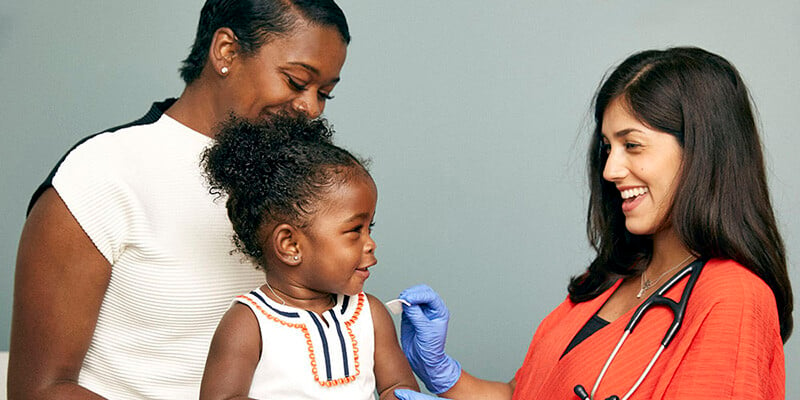Eliminating measles and rubella can be a reality but the effort faces challenges with misinformation spreading across social media adding to vaccine hesitancy.
“Measles and rubella are what we would call ‘obligate human pathogens.’ There's no animal reservoir for either of them, so they are potentially eradicable diseases,” says Sean O’Leary, MD, MPH, professor of pediatrics at the University of Colorado School of Medicine.
In a supplement from earlier this summer, O’Leary and David Higgins, MD, MPH, MS, instructor of pediatrics, both investigators at the Adult and Child Center for Outcomes Research and Delivery Science (ACCORDS), discuss the feasibility of global elimination of measles and rubella.
“These are diseases that we could potentially eradicate, and we have incredibly effective tools to do it. We have the MMR vaccine, which is effective enough that theoretically we could eradicate measles and rubella. However, we have challenges such as hesitancy,” Higgins, who also works as an ACCORDS fellow, says.
The complexity of vaccine hesitancy
Vaccine hesitancy is not new but has been amplified amid the COVID-19 pandemic. The authors detail the history of vaccine hesitancy beginning with the first smallpox vaccine more than 200 years ago.
“I always want to emphasize that the pandemic did not introduce vaccine hesitancy. That was always there. I think it did add to the complexity of addressing vaccine hesitancy,” Higgins says. “Social media has amplified it and created a new platform for the spread of things like misinformation and disinformation and has maybe changed the dynamics of vaccine hesitancy and how we address it.”
Previous data research published by the authors revealed that parents were not extremely hesitant to all vaccines because of, or following, the pandemic.
“We saw some changes in how parents receive vaccine Information, but we did not actually see this large swing in their attitudes towards vaccines in general,” Higgins says.
The researcher’s data shows that most parents still choose to vaccinate their children.
Communication about vaccines is key
The article outlines evidence-based behavioral interventions and communication strategies to address vaccine hesitancy. They are separated into categories for health care professionals, individuals, and overall mass communication.
“Much of vaccine communication, historically, has been predicated on this concept of the information deficit model,” O’Leary says. “You simply provide information, and people will make the right decision, which assumes that human decision making is always rational.”
Research on how to communicate this information is still in its infancy, but Higgins and O’Leary agree that when communicating about vaccines, it's not just the facts that matter.
“A pediatrician, or a family doctor who gives vaccines, needs to know the facts about vaccines, but also how to communicate those facts. And that's true both at the individual level, communicating in the office, but also at the systems level, from local public health departments, state health departments, and CDC (Centers for Disease Control and Prevention),” O’Leary says.
Access encompasses more than vaccines themselves
“Sometimes I hear the conversation about increasing vaccination rates as it's either a problem of hesitancy, there's an attitude problem, or a problem of access. But it's not that straightforward,” Higgins says. “It’s an overlapping issue.”
It is not enough to just get vaccines into communities. It is also a problem when someone in a community has legitimate, good faith questions about vaccines, but doesn’t have access to someone knowledgeable that they trust, that can communicate the necessary information.
“If you see a community with low vaccination rates, and you simply assume that it is all from hesitancy, you're going to miss important interventions to improve access. It’s important that you not presume that low uptake in a certain community is due to hesitancy alone and miss the opportunity to improve access,” Higgins says.
O’Leary uses the World Health Organization’s (WHO) “three Cs” model of vaccine hesitancy: complacency, confidence, and convenience, as an example of access overlap.
“If a person has a doctor’s office next door and during a visit the doctor says, ‘you’re due for a vaccine,’ they can get it and overcome a fair bit of hesitancy. As opposed to someone who has the same level of hesitancy but must overcome a large hassle to go out and find a vaccine,” O’Leary says.
Raising rates in Colorado
Higgins and O’Leary are currently working with the Colorado Department of Public Health and Environment (CDPHE) to increase vaccine uptake in primary care clinics, particularly for measles.
“We're still north of 90% for most childhood vaccines, but measles needs super high coverage to maintain population level protection,” O’Leary says. “It was 95% nationally heading into the pandemic, now it's about 93%. Based on the data we have available, Colorado is in the mid- to high-80s.”
While the measles, mumps, and rubella vaccine is required for students attending Colorado schools (K-12), there are several complicating factors. Families in Colorado can get non-medical exemptions if they choose to opt out. Another issue is children not having access to vaccines and the challenge of getting them. School requirements are meant to help with access challenges, but not all schools are able to enforce them with other competing demands.
“Partnering with health care providers is part of a state level, multi-pronged approach to improving vaccine uptake. CDPHE is also doing media campaigns and mobile vaccine clinics to bring vaccines to communities that don't have it,” Higgins says. “Communicating in all of these different ways is a really important approach to raising MMR rates here in Colorado.”





